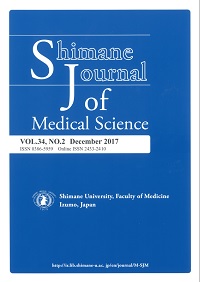Shimane University Faculty of Medicine
ISSN :0386-5959(in print)
ISSN :2433-2410(online)


These article are licensed under a Creative Commons Attribution-NonCommercial-NoDerivatives 4.0 International License.
number of downloads : ?
Use this link to cite this item : https://ir.lib.shimane-u.ac.jp/40554
Shimane Journal of Medical Science 34 1
2017-07-31 発行
Improvement in the Quantification of Striatal Tracer Uptake in Single-photon Emission Computed Tomography With 123I-ioflupane Using a Cadmium-zinc-telluride Semiconductor Camera
Yamamoto, Yasushi
Department of Radiology, Shimane University Hospital
Nishiyama, Yuichi
Department of Radiology
Haramoto, Masuo
Department of Radiology, Shimane University Hospital
Sota, Takumi
Shimane Prefectural Central Hospital
Miyai, Masahiro
Department of Radiology, Shimane University Hospital
Uchibe, Taku
Department of Radiology, Shimane University Hospital
Yada, Nobuhiro
Department of Radiology, Shimane University Hospital
Nishiyama, Yukako
Department of Radiology, Shimane University Hospital
Kitagaki, Hajime
Department of Radiology
File
Description
This study examined the utility of cadmium-zinctelluride (CZT) semiconductor camera for quantifying striatal tracer uptake in single-photon emission computed tomography (SPECT) with 123I-ioflupane (DaTSCAN). An anthropomorphic striatal phantom was prepared with 123I-ioflupane. The phantom images were obtained using a CZT camera and a traditional Anger-type camera for 5 min and 30 min, respectively. Phantom image quality was visually evaluated, and the contrast between the striatal and cerebral parenchyma (background region) was examined via count profile analysis. Then, the specific binding ratio (SBR), which indicates 123I uptake in the striatum, was measured. There were no visual differences in striatal shape between the scans, but the CZT/SPECT scan exhibited better image contrast. The SBR obtained from the CZT/SPECT images were higher than those acquired from the Anger/SPECT images and were closer to the true values. Performing CZT/SPECT using DaTSCAN might enable more accurate evaluations of striatal function while reducing the imaging time.
About This Article
Rights
Faculty of Medicine, Shimane University
Other Article
PP. 7 - 11
PP. 13 - 19
